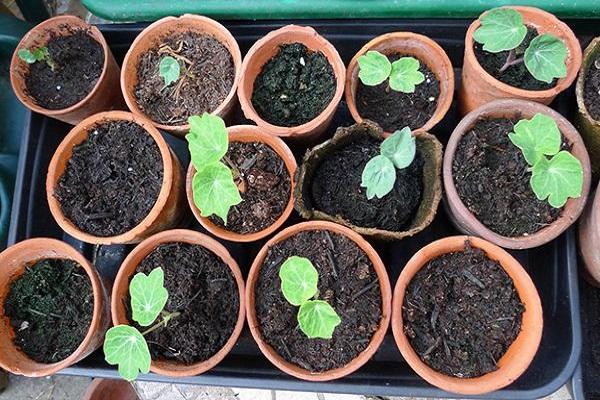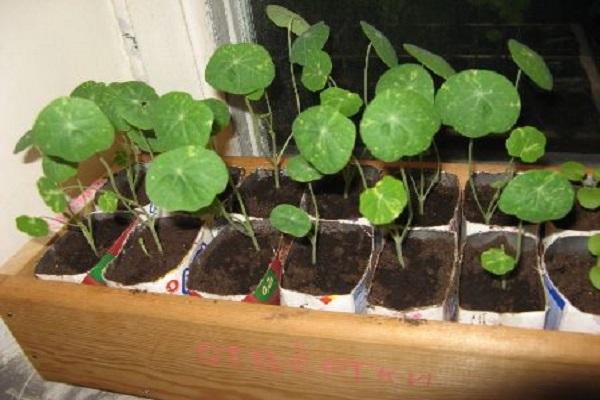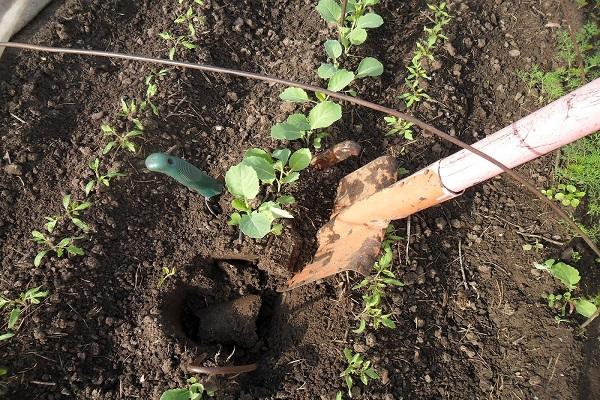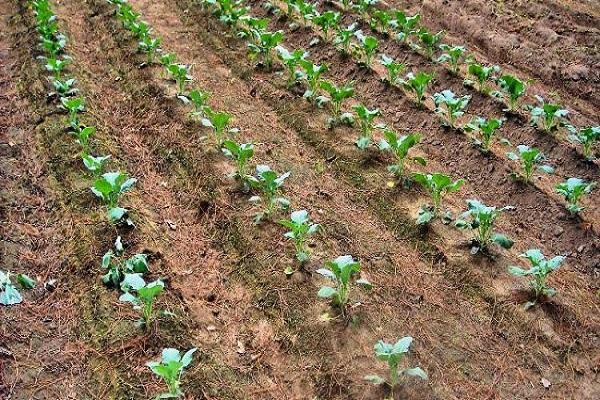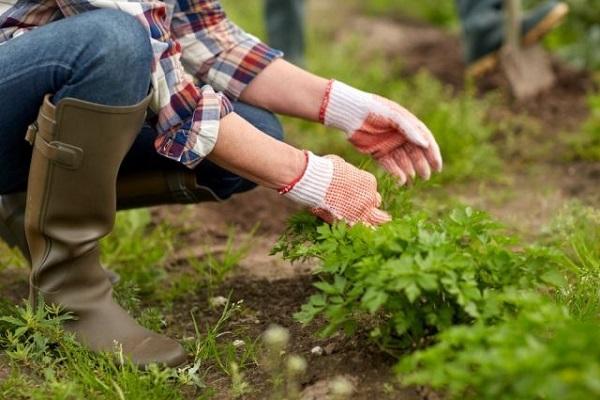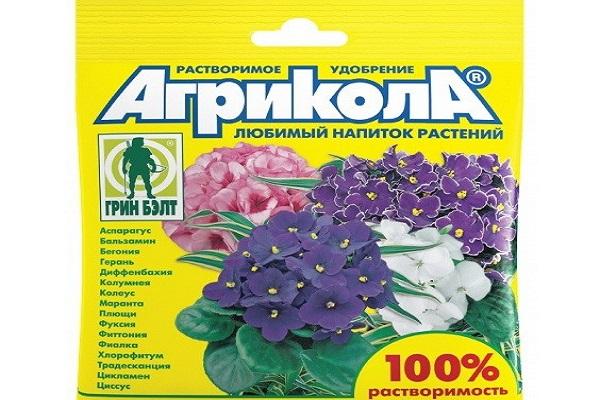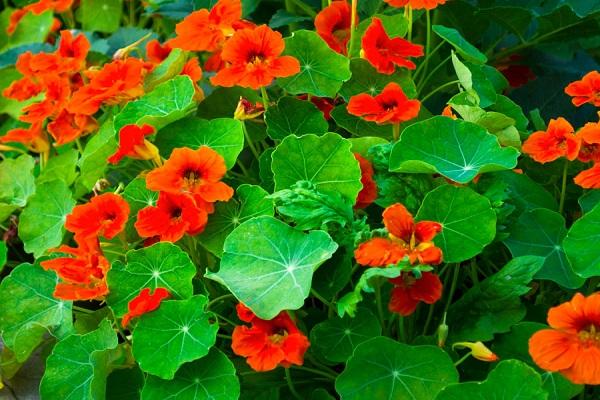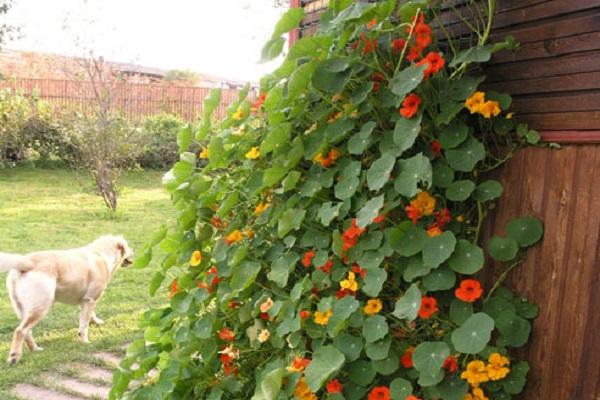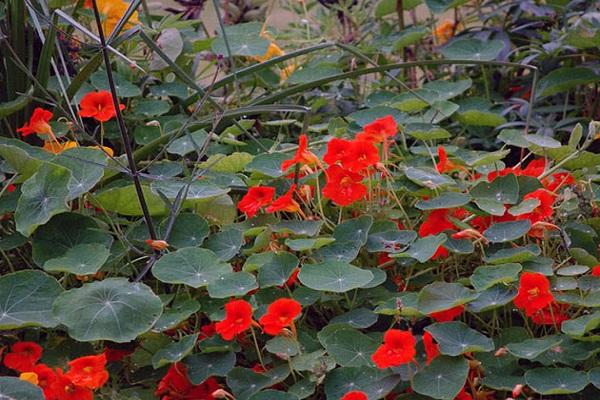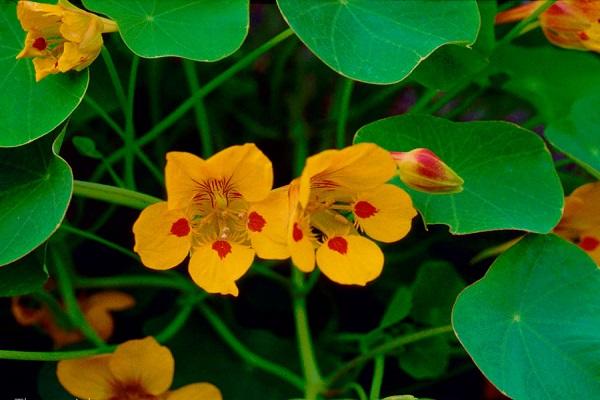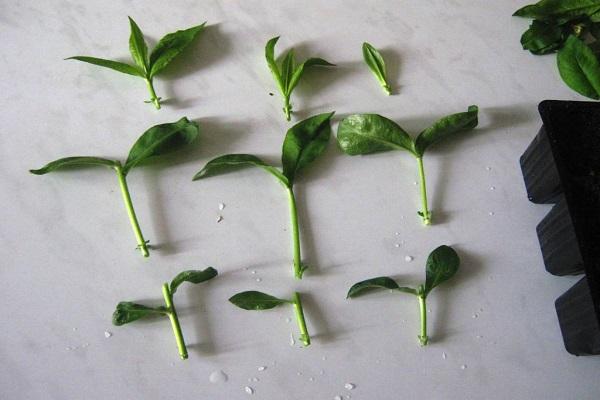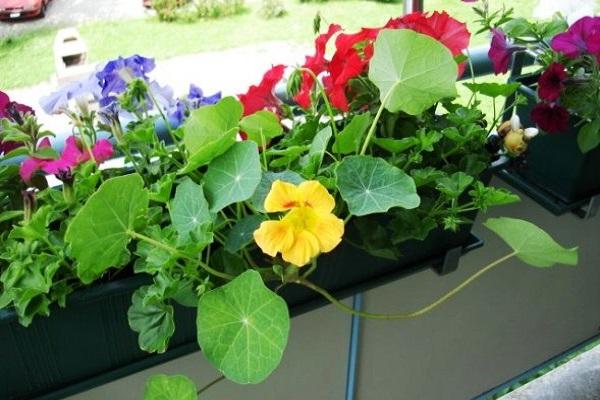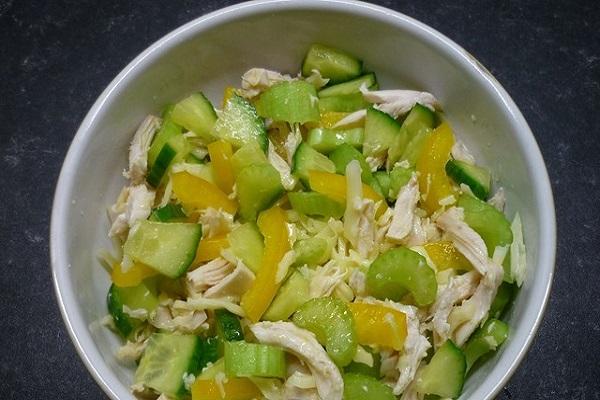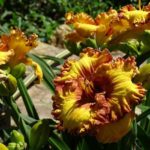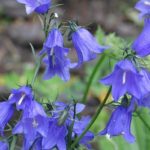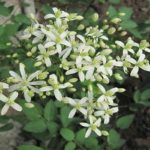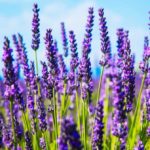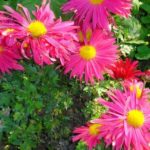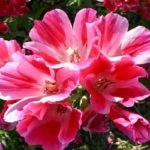Planting and caring for nasturtium is a fairly simple and exciting process. This culture belongs to the Nasturtium family. This plant is native to America. However, now it is popular in different countries. This is due to its ease of care, medicinal properties and the possibility of use for culinary purposes.
- Description and features
- Growing seedlings
- Landing dates
- Selection and preparation of seed material
- How to plant
- Temperature and light conditions
- Picking
- Hardening
- Planting in open ground
- When to plant
- Soil requirements
- Planting scheme
- Care
- Watering
- Loosening and weeding
- Mulching
- Top dressing
- Diseases and pests
- After flowering
- Kinds
- Foreign
- Big
- Cultural
- Small
- Shield-bearing
- Popular varieties
- King Theodore
- Peach Melba
- Salmon Baby
- Ladybug
- Gleming Mahagani
- Golden Globe
- Moonlight
- Cherry rose
- Black Velvet
- Reproduction
- Cuttings
- Seeds
- Dividing the bush
- Features of growing at home
- Usage
- Cooking
- Medicine
Description and features
Nasturtium is an annual or perennial plant. Usually it is a vine that has succulent shoots. In more rare cases, subshrubs can be found. Most often, the leaf blades have a lobed or shield-shaped shape. Palmate and entire leaves are also found..
The culture has fragrant flowers. They can be simple or terry. There are also semi-double options. The composition contains 5 or more petals and the same number of sepals. In addition, there is a funnel-shaped tube that contains nectar. The flowers are usually yellow or red in color. The fruits contain 3 wrinkled lobes with seeds.
Growing seedlings
The simplest method of growing a crop is planting in open soil. However, in cool areas, it is recommended to start the seedlings first and only then place the plants in the soil. This will help speed up the appearance of flowers.
Landing dates
It is permissible to plant seeds for seedlings from the end of March to the first half of April. In areas with cold climates, it is better to shift the timing a little. In such a situation, seedlings are planted in mid-April or early May.
Selection and preparation of seed material
To speed up the appearance of sprouts, it is recommended to soak the seeds in warm water. Its temperature should be about 40 degrees. This is done overnight or for 24 hours. In the second case, it is recommended to change the water once. Soak the planting material in gauze or cotton pads.It is also acceptable to use a glass or plate with a lid.
How to plant
To plant a crop, you should perform the following steps:
- prepare containers for planting;
- fill them with nutritional composition;
- moisten thoroughly;
- You should put 2-4 seeds in one pot;
- deepen into the ground 1.5-2 centimeters;
- sprinkle with earth;
- moisten the soil again;
- put in a dark place.
Temperature and light conditions
When planting seeds, you should monitor the temperature parameters. It can be 20-22 degrees. It is important to ensure that the sprouts receive enough light. Otherwise they will stretch out. After transplanting into the soil, such plants may become sick.
Picking
The plant has rather weak roots. To avoid damaging them, it is not recommended to pick seedlings. It is immediately transferred to open ground with a lump of earth.
Hardening
Before transplanting the plant into open soil, it is recommended to harden the sprouts. To do this, the seedlings are taken outside for 3 days.
Planting in open ground
To grow a strong and viable plant, it is recommended to transplant it correctly into open soil.
When to plant
The crop should be planted in late May or early June. It is at this moment that the risk of return frosts disappears. By this time, the seedlings become quite strong and contain 2-3 true leaves.
Soil requirements
When planting nasturtium, it is important to choose the right soil composition. Too wet soil can cause the plant to die. A very large amount of fertilizer will lead to an increase in green mass. This will negatively affect the size of the flowers. At the same time, too poor soil will not ensure lush flowering.
Soil with low acidity is ideal for growing the crop.It should be quite loose and fertile.
Planting scheme
Plants should be planted in holes. At the same time, you cannot break the earthen lump. The day before planting, it is recommended to water the seedlings well. After planting the crop in the ground, the plant needs to be watered and the ground around it covered with a mulch layer.
The interval between individual bushes should be at least 20 centimeters. With strong growth of nasturtium, a distance of 30-40 centimeters will be required. The crop should be planted in warm and sunny weather. If it is cold enough at night, the bushes are covered with film.
Care
To grow beautiful bushes and abundant flowering of nasturtium, it is necessary to provide it with high-quality and complete care.
Watering
The crop should be watered systematically, but moderately. This is especially true when growing young plants. During the flowering period, watering is carried out exclusively during maximum drought. During the standard season, the plant does not require additional moisture.
Loosening and weeding
After watering, the crop should definitely be loosened. This will improve the access of oxygen to the soil and ensure more active development of the crop. Weeding the beds, which is aimed at destroying weeds, is of no small importance.
Mulching
It is recommended to apply a mulch layer to the bed when planting seedlings. This will help avoid the active development of weeds and ensure long-term soil moisture.
Top dressing
Fertilizers should be applied before flowering and at the very beginning. For this purpose, combined mineral preparations intended for flowers are used. They contain a minimal amount of nitrogen. The most effective include Agricola, Fertika.
The plant does not like fresh manure.With an excess amount of nitrogen, the crop will begin to grow green mass and will practically not bloom.
Diseases and pests
Nasturtium faces the following diseases:
- Gray rot - accompanied by the formation of gray-brown spots on trunks and leaves.
- Rust - characterized by the appearance of black and brown spots on the leaves. Gradually they transform into tubercles.
- Bacterial wilt - in this case, the lower leaves wither first, after which the upper ones suffer.
- Mosaic - this virus provokes the appearance of a mosaic pattern on the leaves.
- Ring spot – characterized by the formation of small spots on the leaves. Around them there is a red-brown border.
Experts advise digging up and destroying infected plants. The remaining bushes should be treated with special means.
After flowering
After the flowering period is over, dried buds should be removed promptly. Thanks to this, it will be possible to extend the flowering period. If you need to collect seeds, you should leave a few ovaries so that the fruits ripen.
Kinds
Today there are many varieties of nasturtium known. Each of them is characterized by certain features.
Foreign
This is a vine native to South America. It is characterized by light green stems. They reach a length of 350 centimeters and quickly braid arbors. The plant blooms from mid-summer until frost. It has bright yellow flowers that are distinguished by ruffled petals.
Big
The culture is characterized by branched stems reaching a length of 250 centimeters. Erect stems are 70 centimeters. The culture blooms profusely from June until autumn frosts. It spreads well on its own. Moreover, seed germination remains for 4 years.
Cultural
The plant is a hybrid of 2 types of nasturtium - shield-bearing and large.It is characterized by dense foliage. Varieties of this nasturtium differ in size. Compact plants reach a height of 50 centimeters, and creeping ones - 4 meters. There are also dwarf crops. Their height does not exceed 15-20 centimeters.
Small
The culture is characterized by thin branched stems 35 centimeters in height. The leaves have a round shape. The flowers are quite small and do not exceed 3 centimeters. They are distinguished by a yellow tint and covered with dark spots. The culture blooms in June-October.
Shield-bearing
It is a creeping subshrub. It is characterized by fragile shoots that reach 4 meters. The leaves are distinguished by their thyroid shape and rich green tint. The flowers are dark red in color. The plant blooms from June to October.
Popular varieties
There are many popular varieties that are characterized by certain characteristics.
King Theodore
Nasturtiums of this variety are characterized by rather rich flowers. They have a bright red hue.
Peach Melba
This culture has delicate cream-colored flowers. Red spots can be seen in the central part of the inflorescence.
Salmon Baby
The culture is characterized by semi-double flowers. They are distinguished by a delicate salmon hue.
Ladybug
This plant has flowers of a beautiful apricot color. In the middle of each of them there are burgundy spots.
Gleming Mahagani
This nasturtium grows in the form of a bush, which can reach 37 centimeters in height. It is characterized by double red flowers.
Golden Globe
The plant is a ball-shaped bush. It reaches 25 centimeters in height and 40 centimeters in width. It is characterized by rounded leaves and large flowers of a golden yellow hue.
Moonlight
This plant climbs beautifully. Its stems can reach 2 meters in length. The flowers have a pale yellow hue.
Cherry rose
This variety can grow up to 30 centimeters in height. It is characterized by double flowers of rich red color.
Black Velvet
This nasturtium also grows 30 centimeters. It is characterized by simple flowers with a diameter of 6 centimeters. They have a dark burgundy hue.
Reproduction
There are different methods for propagating nasturtium. This allows each gardener to choose the best option.
Cuttings
Nasturtium is propagated very rarely in this way. This is usually done to obtain new varieties. To root young cuttings, you should use water or wet sand. After which they are planted in open ground.
Seeds
First, the seeds need to be soaked in water or a special solution. After which they are planted in a warm area after the end of the night frosts. To get sprouts after 2 weeks, place several seeds in each hole.
Dividing the bush
Nasturtium is not propagated using this method. This is due to the fragility of the plant's root system.
Features of growing at home
The culture is actively used to decorate verandas and balconies. To do this, the crop should be planted in a pot. It is important that the container is wide and not too deep. The container should be placed on an open balcony or in a place that is well lit. It is important to systematically water the plant and apply fertilizer.
Usage
Nasturtium is considered a very useful crop. It is actively used for medicinal purposes and in cooking.
Cooking
Young leaves and inflorescences are used to improve the taste of salads and soups. They are put into sandwiches and used for decorative purposes. The fruits can be pickled.The seeds are also dried and crushed, after which they are used as a seasoning.
Medicine
The healing properties of nasturtium make it possible to use it to combat skin rashes, vitamin deficiency, and anemia. The plant also helps cope with kidney stones.
Nasturtium is a unique plant that is used for decorative purposes. It is actively used in folk medicine and cooking. To grow a strong crop, you need to follow the basic recommendations of experienced gardeners.

